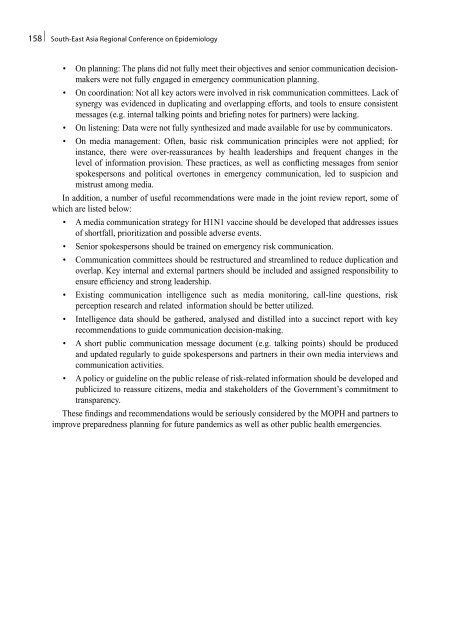South-East Asia Regional Conference on Epidemiology
South-East Asia Regional Conference on Epidemiology
South-East Asia Regional Conference on Epidemiology
You also want an ePaper? Increase the reach of your titles
YUMPU automatically turns print PDFs into web optimized ePapers that Google loves.
158 | <str<strong>on</strong>g>South</str<strong>on</strong>g>-<str<strong>on</strong>g>East</str<strong>on</strong>g> <str<strong>on</strong>g>Asia</str<strong>on</strong>g> <str<strong>on</strong>g>Regi<strong>on</strong>al</str<strong>on</strong>g> <str<strong>on</strong>g>C<strong>on</strong>ference</str<strong>on</strong>g> <strong>on</strong> <strong>Epidemiology</strong><br />
• On planning: The plans did not fully meet their objectives and senior communicati<strong>on</strong> decisi<strong>on</strong>makers<br />
were not fully engaged in emergency communicati<strong>on</strong> planning.<br />
• On coordinati<strong>on</strong>: Not all key actors were involved in risk communicati<strong>on</strong> committees. Lack of<br />
synergy was evidenced in duplicating and overlapping efforts, and tools to ensure c<strong>on</strong>sistent<br />
messages (e.g. internal talking points and briefing notes for partners) were lacking.<br />
• On listening: Data were not fully synthesized and made available for use by communicators.<br />
• On media management: Often, basic risk communicati<strong>on</strong> principles were not applied; for<br />
instance, there were over-reassurances by health leaderships and frequent changes in the<br />
level of informati<strong>on</strong> provisi<strong>on</strong>. These practices, as well as c<strong>on</strong>flicting messages from senior<br />
spokespers<strong>on</strong>s and political overt<strong>on</strong>es in emergency communicati<strong>on</strong>, led to suspici<strong>on</strong> and<br />
mistrust am<strong>on</strong>g media.<br />
In additi<strong>on</strong>, a number of useful recommendati<strong>on</strong>s were made in the joint review report, some of<br />
which are listed below:<br />
• A media communicati<strong>on</strong> strategy for H1N1 vaccine should be developed that addresses issues<br />
of shortfall, prioritizati<strong>on</strong> and possible adverse events.<br />
• Senior spokespers<strong>on</strong>s should be trained <strong>on</strong> emergency risk communicati<strong>on</strong>.<br />
• Communicati<strong>on</strong> committees should be restructured and streamlined to reduce duplicati<strong>on</strong> and<br />
overlap. Key internal and external partners should be included and assigned resp<strong>on</strong>sibility to<br />
ensure efficiency and str<strong>on</strong>g leadership.<br />
• Existing communicati<strong>on</strong> intelligence such as media m<strong>on</strong>itoring, call-line questi<strong>on</strong>s, risk<br />
percepti<strong>on</strong> research and related informati<strong>on</strong> should be better utilized.<br />
• Intelligence data should be gathered, analysed and distilled into a succinct report with key<br />
recommendati<strong>on</strong>s to guide communicati<strong>on</strong> decisi<strong>on</strong>-making.<br />
• A short public communicati<strong>on</strong> message document (e.g. talking points) should be produced<br />
and updated regularly to guide spokespers<strong>on</strong>s and partners in their own media interviews and<br />
communicati<strong>on</strong> activities.<br />
• A policy or guideline <strong>on</strong> the public release of risk-related informati<strong>on</strong> should be developed and<br />
publicized to reassure citizens, media and stakeholders of the Government’s commitment to<br />
transparency.<br />
These findings and recommendati<strong>on</strong>s would be seriously c<strong>on</strong>sidered by the MOPH and partners to<br />
improve preparedness planning for future pandemics as well as other public health emergencies.









